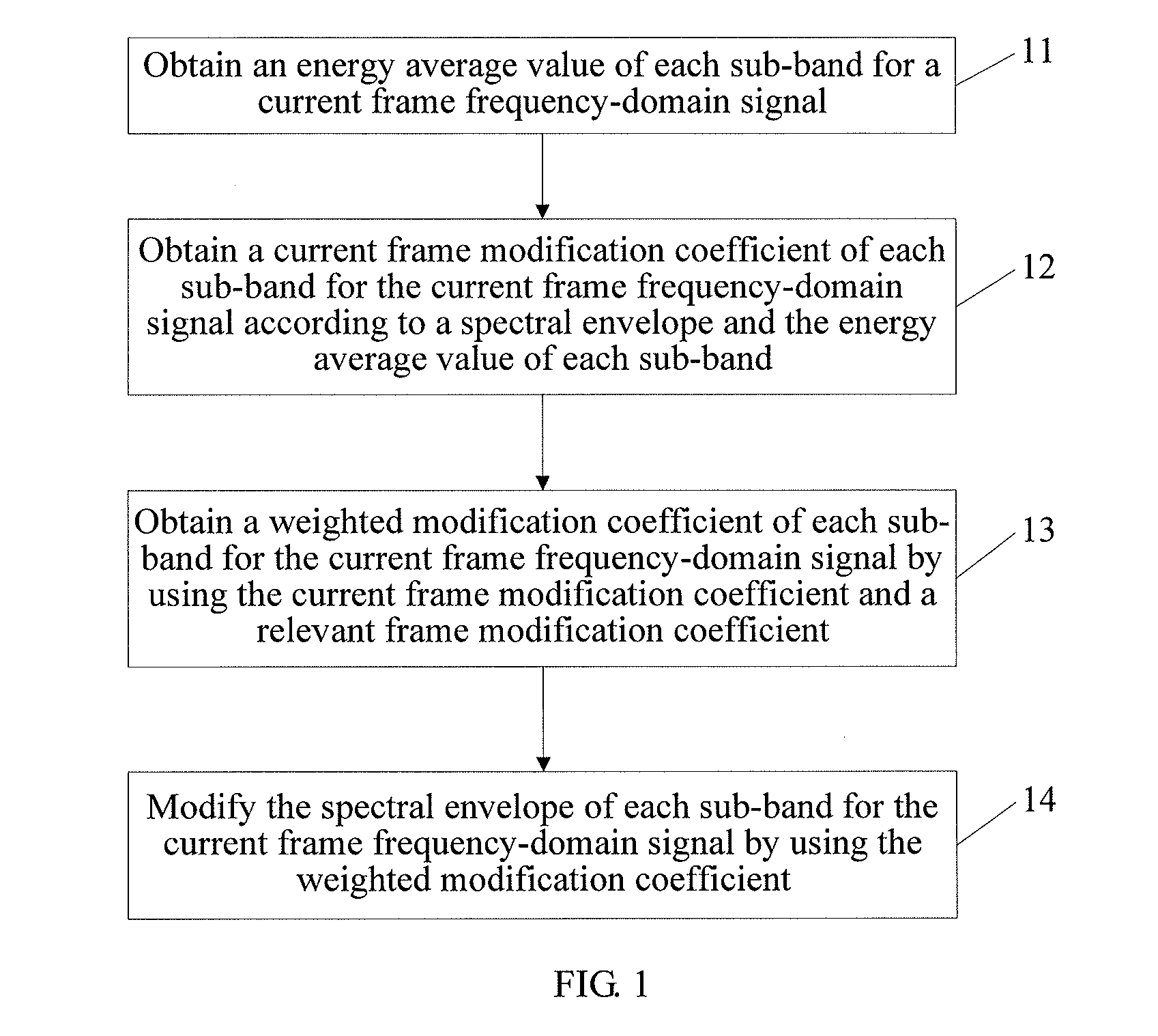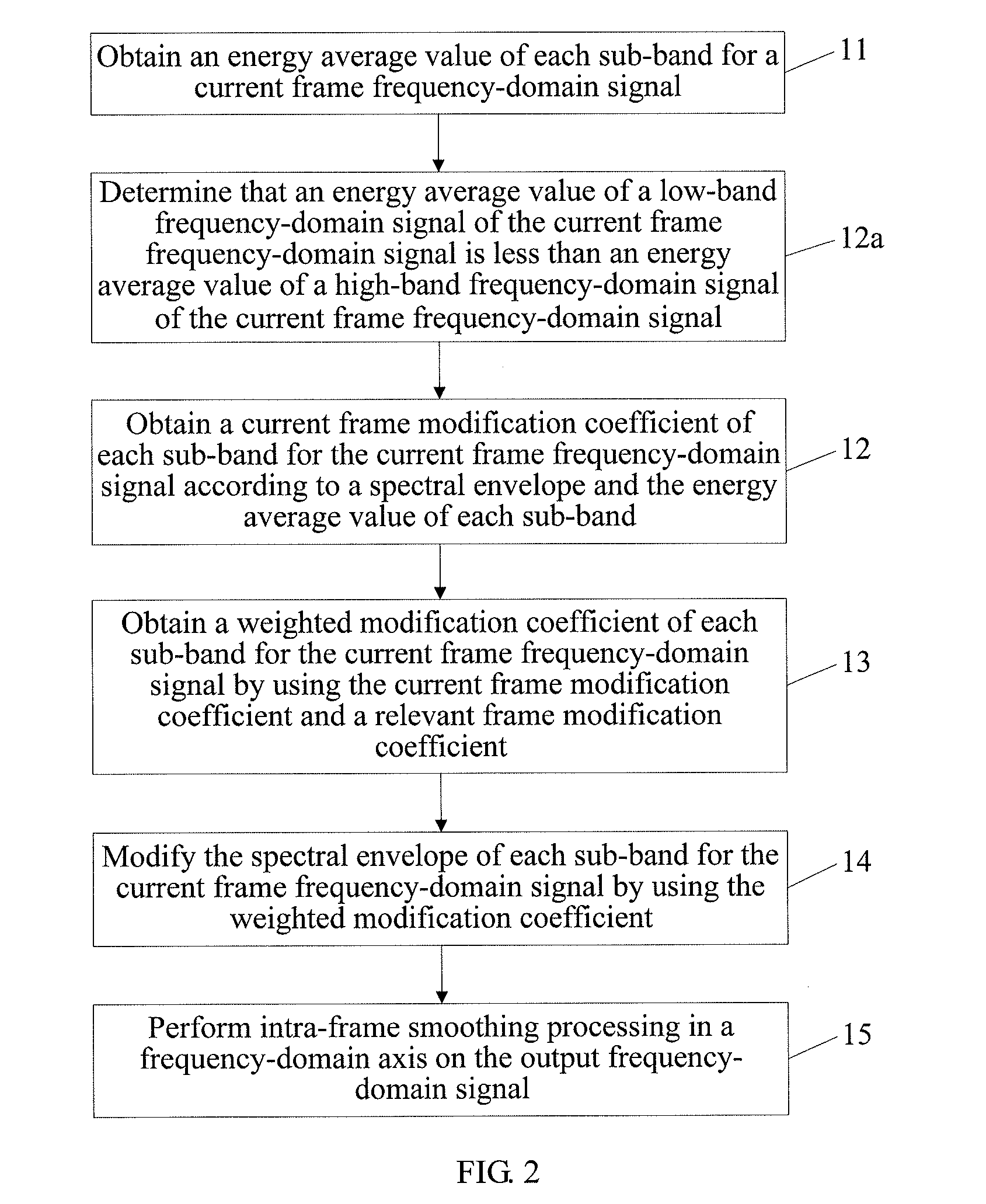Method and apparatus for processing signal
- Summary
- Abstract
- Description
- Claims
- Application Information
AI Technical Summary
Benefits of technology
Problems solved by technology
Method used
Image
Examples
embodiment 1
[0037]In order to reduce noises in an output signal and improve the quality of the output signal, as shown in FIG. 1, Embodiment 1 of the present invention provides a method for processing a signal, which includes the following steps:
[0038]Step 11: Obtain an energy average value of each sub-band for a current frame frequency-domain signal.
[0039]In this step, time-frequency transform is performed on an input current frame time-domain signal, to obtain the current frame frequency-domain signal. For example, the corresponding current frame frequency-domain signal may be obtained from the current frame time-domain signal through methods such as Modified Discrete Cosine Transform (MDCT) or Fast Fourier Transform (FFT). Then, the energy average value of each sub-band is calculated. In the calculation of the energy average value of each sub-band, a method in the prior art may be employed, which is not described in detail herein again.
[0040]Step 12: Obtain a current frame modification coeff...
embodiment 2
[0065]As shown in FIG. 3, the method for processing a signal according to Embodiment 2 includes the following steps:
[0066]Step 31: Obtain an energy average value of each sub-band for a current frame frequency-domain signal.
[0067]Similar to the description in Embodiment 1, time-frequency transform is performed on an input current frame time-domain signal, to obtain the current frame frequency-domain signal. For example, the corresponding current frame frequency-domain signal may be obtained from the current frame time-domain signal through methods such as MDCT or FFT. Then, the energy average value of each sub-band is calculated.
[0068]Step 32: Determine that an energy average value of a low-band frequency-domain signal of the current frame frequency-domain signal is less than an energy average value of a high-band frequency-domain signal of the current frame frequency-domain signal.
[0069]In this process, following the manner as described in Embodiment 1, the current frame frequency-d...
embodiment 3
[0082]In the method for processing a signal according to Embodiment 3, time-frequency transform is performed on an input current frame time-domain signal first at an encoder, to obtain a corresponding current frame frequency-domain signal. Then, the current frame frequency-domain signal is quantized and sent to a decoder. As shown in FIG. 4, the method for processing a signal according to Embodiment 3 of the present invention includes the following steps:
[0083]Step 41: Obtain a current frame frequency-domain signal sent from an encoder, and dequantize the current frame frequency-domain signal to obtain a decoded current frame frequency-domain signal. This process is the same as that in the prior art, and is not described in detail herein again.
[0084]Step 42: Determine that an energy average value of a low-band frequency-domain signal of the current frame frequency-domain signal is less than an energy average value of a high-band frequency-domain signal of the current frame frequency...
PUM
 Login to View More
Login to View More Abstract
Description
Claims
Application Information
 Login to View More
Login to View More - R&D Engineer
- R&D Manager
- IP Professional
- Industry Leading Data Capabilities
- Powerful AI technology
- Patent DNA Extraction
Browse by: Latest US Patents, China's latest patents, Technical Efficacy Thesaurus, Application Domain, Technology Topic, Popular Technical Reports.
© 2024 PatSnap. All rights reserved.Legal|Privacy policy|Modern Slavery Act Transparency Statement|Sitemap|About US| Contact US: help@patsnap.com










